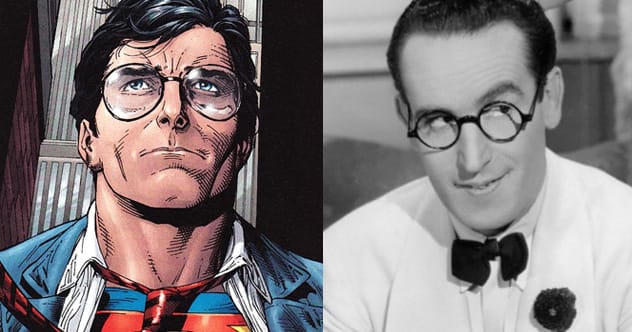Have you ever wondered where comic book creators find their ideas? The most memorable characters often have roots in real life. It’s true! Many famous heroes and villains were inspired by actual people. Let’s dive into 10 fascinating stories of real individuals who sparked the creation of some of the most iconic figures in comics.
Clark Kent (Superman) & Harold Lloyd
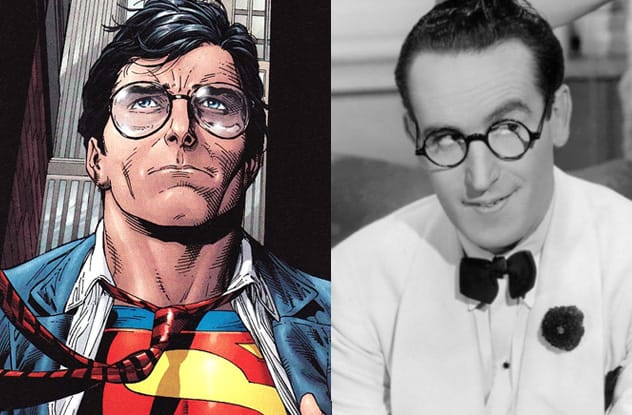
Superman’s journey to becoming a hero was a long one. At first, in 1933, creator Jerry Siegel imagined a bald, telepathic villain. This early “Super-man” was inspired by philosopher Friedrich Nietzsche’s idea of an “Ubermensch,” a powerful being beyond ordinary morality. Siegel wrote the story, and his friend Joe Shuster drew it.
Over five years, Siegel and Shuster changed Superman into a hero. They took ideas from figures like Moses and Samson, and fictional heroes like Hercules and Doc Savage. For Superman’s heroic look, they thought of movie star Douglas Fairbanks. But for his mild-mannered alter ego, Clark Kent, they looked to another actor: Harold Lloyd. Lloyd was famous for playing characters who looked meek but possessed hidden strength and athleticism. This was perfect for Clark Kent, who needed to hide his super abilities.
Some believe Superman’s story of losing his parents and home planet came from Siegel’s own life. His parents were immigrants, and his father died shortly before Superman first appeared. Siegel and Shuster sold Superman’s rights for only $130. They didn’t get more money until the 1970s when DC Comics gave them pensions for life.
Lois Lane & Glenda Farrell
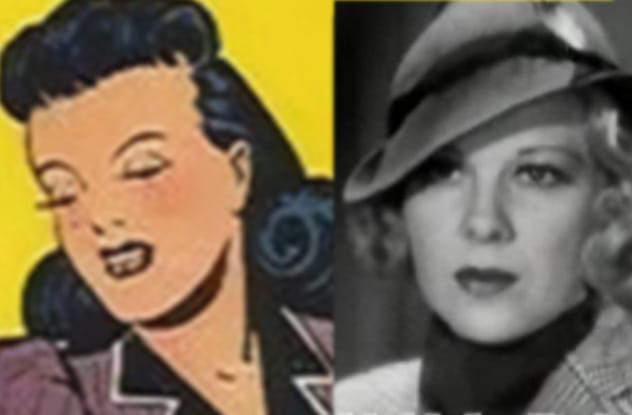
While Clark Kent had his real-life model, so did his famous love interest, Lois Lane. For a long time, people thought Jerry Siegel based Lois on a girl he knew in high school. But Siegel said this wasn’t true.
He explained that his girlfriend at the time, Joanne, modeled for Joe Shuster’s drawings of Lois. However, the core inspiration for Lois’s personality came from movie star Glenda Farrell. Farrell played Torchy Blane, a tough, smart, and beautiful reporter who was always chasing a big story. This was exactly what Siegel wanted for Lois. Torchy Blane appeared in a series of popular films in the late 1930s. Farrell starred in most of them as the determined news reporter.
Siegel said that as time went on, Lois’s personality started to resemble Joanne more, who later became his wife. And the name “Lois Lane”? It was inspired by actress Lola Lane, who also played Torchy Blane in one film. Siegel liked the sound of her name and adapted it for his character.
Erik Lehnsherr (Magneto) & Malcolm X
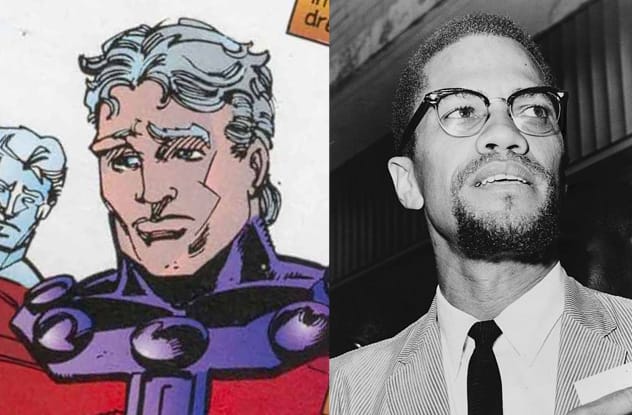
When Stan Lee and Jack Kirby created the X-Men in 1963, they were thinking about the civil rights movement. Their stories about mutants facing discrimination mirrored the struggles of the era. The two most powerful mutants they introduced, Professor X and Magneto, were inspired by two key civil rights leaders.
Professor Charles Xavier, who believed in peaceful coexistence and education, was based on Martin Luther King Jr. He taught that mutants could help society and should not be feared. On the other hand, Magneto (Erik Lehnsherr) had a different approach. He believed mutants should fight for their rights, using strength and even intimidation if necessary. This made him a parallel to Malcolm X, who advocated for a more confrontational stance against intolerance.
Stan Lee mentioned that he didn’t see Magneto as a simple villain. He felt Magneto was reacting to prejudice and racism, trying to defend mutants from a society that treated them unfairly. Magneto was a complex character, driven by his own harsh experiences and a desire to protect his people.
Tony Stark (Ironman) & Howard Hughes / Elon Musk

The brilliant, rich, and charming Tony Stark, also known as Iron Man, owes his existence to a real-life tycoon: Howard Hughes. Stan Lee admitted that Hughes was a major inspiration. Both Stark and Hughes inherited fortunes from their fathers, were innovative inventors, and were known for their playboy lifestyles. They also both supplied military technology to the U.S. government during the Cold War. Lee even named Tony’s father “Howard.”
Lee found Hughes fascinating because he was an inventor, adventurer, a hit with the ladies, and also a bit eccentric. Lee described Tony Stark in a similar way: a handsome millionaire, equally comfortable in a lab or at a high-society party. When the Iron Man movies were made, actor Robert Downey Jr. wanted a modern example of such a figure. He turned to Elon Musk, the co-founder of PayPal and CEO of SpaceX. Downey studied Musk’s mannerisms to make his Tony Stark believable. Jon Favreau, the director of Iron Man, was so impressed by Musk that he adjusted the script to make Tony Stark even more like him. Musk even had a cameo in Iron Man 2.
Joker & Conrad Veidt
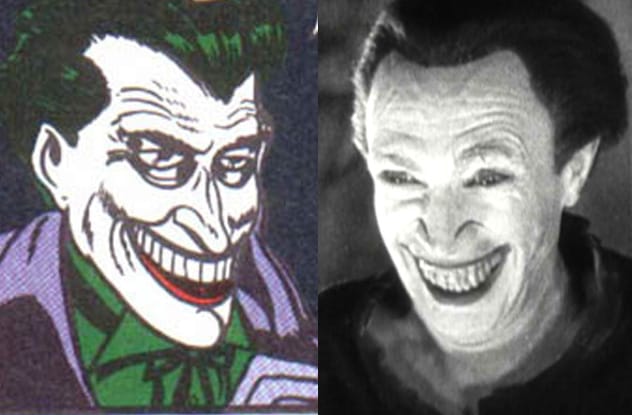
The Joker is one of the most famous villains in comic book history. There’s been a long debate about who exactly created him. Bob Kane, Bill Finger, and Jerry Robinson all worked at Detective Comics. Kane and Finger said they already had the idea for the Joker when Robinson showed them a playing card with a joker on it. Robinson, however, claimed he came up with the Joker character entirely.
Robinson wanted a visually striking villain, someone memorable and bizarre. He thought a villain with a sense of humor would be unique. The name “Joker” came to him, along with the image of a playing card. Despite the debate over his conceptual origin, all three creators agreed on one thing: the Joker’s eerie look was inspired by German actor Conrad Veidt. Specifically, it was Veidt’s role as Gwynplaine in the 1928 silent film The Man Who Laughs. In the movie, Gwynplaine’s face is horrifically carved into a permanent smile. This haunting image became the basis for the Joker’s iconic grin.
J. Jonah Jameson & Stan Lee
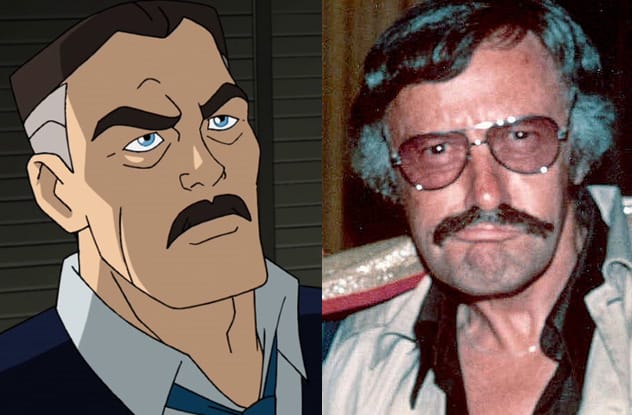
J. Jonah Jameson, the loud and grumpy publisher of The Daily Bugle and Peter Parker’s boss, has a surprising inspiration: Stan Lee himself! Lee admitted, “He was me! He was irascible, he was bad tempered, he was dumb, he thought he was better than he was.” Steve Ditko co-created the character with Lee.
Unlike Clark Kent’s boss Perry White, who admired Superman, Lee and Ditko wanted irony. They made Jameson hate Spider-Man, the very hero whose photos sold his newspapers. This created constant tension. Jameson also famously disliked teenagers, which was ironic since Marvel’s main audience was teens. This resonated with young readers who often felt misunderstood by adults.
Jameson’s character also led to some important moments in comics. For example, Lee introduced Robbie Robertson, a black editor at the Bugle, who often acted as Jameson’s conscience. This was a step forward for diversity in comics. Interestingly, Stan Lee’s wife was named Joan, and Jameson’s first wife was also named Joan. Lee even wanted to play Jameson in the Spider-Man movies, but that role went to J.K. Simmons, though Lee made many other cameos.
Princess Diana (Wonder Woman) & Elizabeth Marston / Olive Byrne
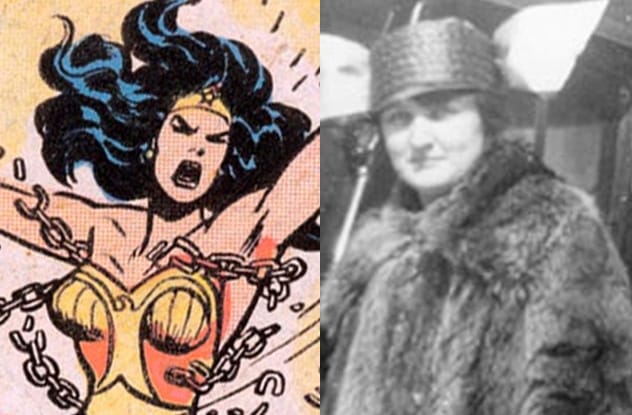
Wonder Woman was created in 1941 by psychologist William Moulton Marston as a symbol of strong, free, and courageous womanhood. He wanted to show that women were not inferior to men and to inspire girls. Marston actually believed women were superior and should rule the world to achieve peace.
Marston was hired by All-American Publications (a forerunner to DC Comics) to create a new kind of superhero. He decided a female hero was needed. The inspiration for Wonder Woman came directly from two women in his life: his wife, Elizabeth Holloway Marston, and their partner, Olive Byrne. Elizabeth was a highly educated woman who helped Marston with his research, including work that led to the lie detector. Olive Byrne was Marston’s former student, and they all lived together in a polyamorous relationship. Byrne wore distinctive cuff bracelets, which became Wonder Woman’s iconic bullet-deflecting bracelets.
Both women were feminists. Olive Byrne was the niece of Margaret Sanger, a famous birth control advocate. Elizabeth suggested that Marston’s new hero should be a woman and even contributed some of Wonder Woman’s famous catchphrases like “Great Hera!” The character came from an island of Amazon women, reflecting feminist ideals of a female utopia.
Wolverine & Paul D’Amato
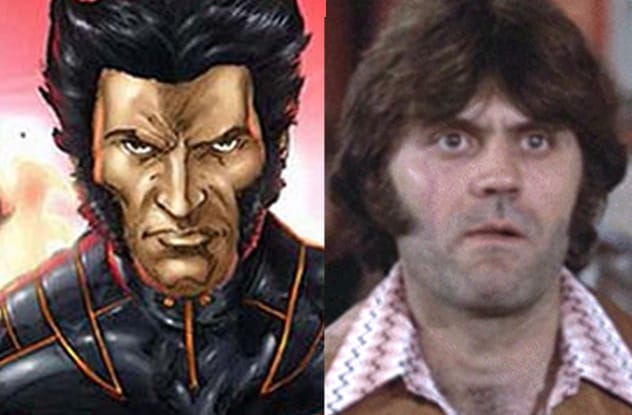
Wolverine’s creation is a bit complicated. He first appeared in The Incredible Hulk in 1974, meant to be a one-off Canadian character. Stan Lee and editor Roy Thomas asked writer Len Wein and artist John Romita Jr. to create a Canadian hero or villain named after a northern animal. Wein chose “wolverine” over “badger.”
A year later, Wolverine joined the X-Men. For a while, his backstory wasn’t developed. When artist John Byrne, who was Canadian, started working on X-Men in 1977, Marvel was thinking of dropping Wolverine. Byrne didn’t want to lose a Canadian character and worked hard to make Wolverine the popular hero he is today.
By the time Byrne took over, Wolverine’s mask and signature pointy hairstyle were already set. Byrne, however, gave Logan a tougher, more rugged look. He found inspiration in actor Paul D’Amato’s portrayal of Dr. Hook in the 1977 movie Slap Shot. D’Amato’s character had wild hair, thick sideburns, a grizzled face, and an aggressive personality. This look and attitude perfectly matched Byrne’s vision for Wolverine, solidifying the character’s iconic appearance.
Elmer Fudd & Robert Ripley
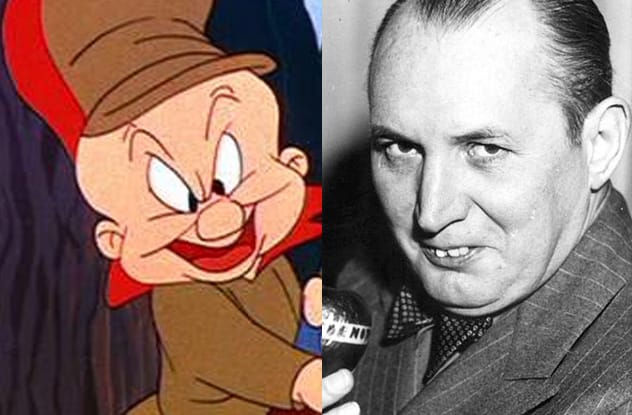
Elmer Fudd, the bumbling hunter always after Bugs Bunny and Daffy Duck, didn’t start in comics. He was a regular in Warner Brothers’ Looney Tunes cartoons. However, starting in 1941, Dell Comics began publishing comics featuring Warner’s cartoon characters, including Elmer.
The inspiration for Elmer Fudd came from Robert Ripley, the creator of “Ripley’s Believe It or Not!” Ripley was a huge celebrity in the 1930s with popular newspaper cartoons, books, and a radio show. Warner Brothers also produced short films with him. Ripley had a noticeable speech impediment; his protruding teeth made it hard for him to close his mouth completely, causing him to lisp and pronounce ‘b’s as ‘v’s. This, along with his somewhat shy demeanor, made him endearing to the public.
Warner Brothers Looney Tunes created a character based on Ripley, initially named Egghead. This character had a large, egg-shaped head like Ripley’s and the same speech impediment. In a 1939 cartoon called Believe It or Else, Egghead even dressed in a loud suit and spats, Ripley’s signature style. Later, Egghead evolved into the character we know as Elmer Fudd, forever “hunting wabbits.”
Bruce Wayne (Batman) & Douglas Fairbanks
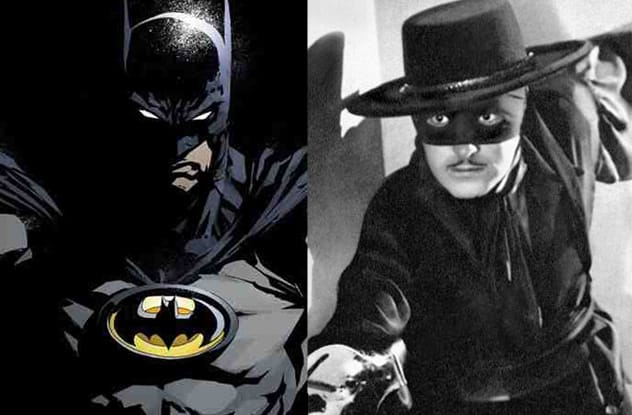
Just like they did with the Joker, creators Bob Kane and Bill Finger found inspiration for Batman in a movie role. The 1920 silent film Mark of Zorro, starring Douglas Fairbanks, was a key influence. Fairbanks’s portrayal of Zorro showcased charm, humor, and incredible athleticism. These qualities, along with Zorro’s mask, costume, secret hideout, and dual identity (especially the wealthy public persona), were all incorporated into Batman.
Other influences included fictional detectives like Doc Savage and Sherlock Holmes, which inspired Batman’s scientific mind and detective skills. Kane initially wanted Batman to have bat-like wings based on Leonardo da Vinci’s sketches. However, Finger suggested a cape and a hooded cowl with pointed ears to make him look more bat-like. Finger also came up with the name Bruce Wayne. “Bruce” came from the Scottish hero Robert the Bruce, and “Wayne” from American Revolutionary War hero General “Mad Anthony” Wayne. Together, these elements formed the Dark Knight we know today.
It’s amazing to see how real people and their stories can shape the fictional characters we love. These inspirations add depth and a touch of reality to the fantastical world of comic books.
Which of these real-life inspirations surprised you the most? Or do you know of any others? Leave your comment below!


